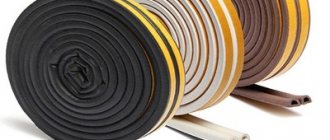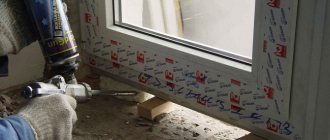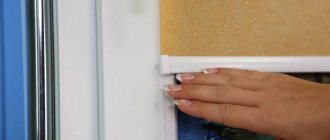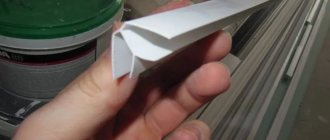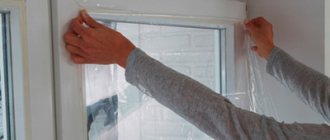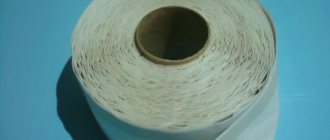How to glue thermal tape on windows. How to insulate old wooden windows for the winter
This short article will tell you how you can quickly and without significant costs insulate old wooden windows for the winter.
Personally, I encountered the problem of window insulation when I rented an apartment. In summer and early autumn the apartment was comfortable, but when severe frosts began, the old wooden windows began to feel cold. The main source of cold was the cracks at the bottom of the window - between the frame and the window sill.
The method that will be discussed below will help to cope with the problem temporarily, which is, in principle, suitable when the apartment is not yours or you are just planning renovations.
To insulate windows, we need a special material - thermal tape.
This is a very common and inexpensive material. The average retail price of a roll (length - 10 m, width 50 mm) is approximately 30 rubles. One roll is enough to insulate a standard kitchen window in a Khrushchev-era apartment building. That is, for a two-room apartment you will need 3-4 rolls, which in total will be 90-120 rubles.
The thermal tape is self-adhesive, that is, an adhesive composition is already applied to its surface, which is a big plus. It is also worth noting that the glued heat tape holds securely, but if necessary, it can be easily removed without damaging the paintwork or leaving marks. This material, useful for the home, is made of polyethylene foam, which has excellent thermal insulation properties.
It is recommended to carry out work on window insulation at temperatures above +10 o C, this will ensure reliable adhesion of the adhesive composition of the material to the surface of the window frame, slopes and window sill.
We take a roll of thermal tape and glue the window around the perimeter, as well as between the sashes.
Smooth the glued area with your hand, cut off the excess with a construction knife or scissors. The entire process of insulating windows is very simple and takes a minimum of your time. Comfort and warmth to your home!
Insulation with cotton wool and foam rubber
An inexpensive and simple way to insulate is to seal cracks with industrial wool. It has good thermal insulation properties, is easy to install and remove when the weather gets hot. The cotton wool is placed by hand, pushing it inside with a spatula or screwdriver. Fabric tape is glued on top to avoid marks when removing, since paper always leaves stains that are difficult to wash off.
In old wooden windows, the sashes dry out greatly, forming large cracks. It is easy to cover them with foam tapes. Self-adhesive tapes are available for sale that easily adhere to the sash. Ordinary foam rubber is secured with nails. Fabric or paper is glued on top.
How to seal windows with soap. How to glue windows with soap for the winter
We glue windows with soap
Man has always thought about improving living conditions and the comfort of his home. This has always been the case at all times. Strong winds and harsh winters leave little choice, forcing residents to seal their windows and insulate their homes. Of course, at the current stage of development of the construction industry there are many modern technologies for sealing windows and further retaining heat. Also, no one has canceled expensive plastic windows, which can forever solve the issue of saving heat in your apartment.
But not every family can afford to buy modern windows, and they are simply accustomed to gluing windows with soap for the winter the old fashioned way. Or in some other old and proven way, it doesn’t matter. There are a large number of old and quite effective methods for sealing windows that remain relevant to this day. We will discuss the most famous and widely used, affordable method of sealing windows using strips of paper or fabric and simple laundry soap.
Eliminating shortcomings
The primary task before starting window covering is the following.
There are more convenient pasting methods
It is necessary to carefully examine all potentially dangerous places from where cold air can pass into the room. Determine how you want to insulate your windows. Then you need to purchase materials and available tools, if necessary. One of the simplest and most affordable methods of insulation is to cover windows with soap for the winter. This is the most popular and beloved method that our grandmothers and mothers used in those years when there was no talk of other innovations. The work, in principle, did not require much physical effort and consisted of several stages:
- Carefully seal all detected cracks with rags or cotton wool using a knife;
- cut strips of paper;
- soak the pieces of paper in soapy water and carefully stick them on the window frames.
The main advantage of this method is that the white paper or fabric is not noticeable and does not interfere with the aesthetic appearance of the window. The soap itself simultaneously serves as an adhesive and sealant, and also does not allow cold or wind to pass through. Also, already cut paper or fabric strips can be used several times without losing the quality of window insulation. The disadvantage of this budget method is that if there is a sharp change in temperature, the paper may peel off.
When the warm season approaches, strips of paper or fabric can be easily and without much physical effort peeled off by simply moistening them with warm water. Typically, this very affordable and effective method is used to cover old wooden windows. In addition, instead of cotton wool, you can use other materials that are available on the farm. https://www.youtube.com/watch?v=diWmEA1RPlI
Last few tips
Before the cold weather, every person begins to think about such an important question: how to save heat and insulate windows? This issue is all the more relevant and acute given the increasing prices for energy resources. It is known that poorly laminated windows do not retain even half the heat. Now there are modern insulating materials that allow you to effectively cover windows and contribute to impressive heat retention. But with such a variety of means, the choice always remains only with the person, which method of insulating windows, modern or old-fashioned, to choose.
When is the use of film justified?
Manufacturers of thermal insulating films for windows recommend using them for gluing to the glass of windows, houses, and apartments in the autumn-winter period, that is, from October to March. During this period, protecting windows from heat leakage is justified. The sun's rays that tend to enter the room have almost no heat, so the reflection of the UV part of the solar spectrum is not significant. The film is completely transparent and does not tint the windows. Infrared (warm) rays that come from heating devices are reflected from the windows back into the room, retaining heat.
The effectiveness of the film depends on the method of gluing it to the glass.
Films come in the following types:
- Heat shrink. They have the ability to stretch when they are heated with a warm air stream. Since the film is glued to double-sided tape, it plays the role of additional glass, enhancing the thermal insulation properties of the double-glazed window.
- A film that is glued to glass using a soap mixture.
- Self-adhesive film.
For reference. Energy-saving film is available in various colors: bronze, gold, blue, silver. Therefore, it is easy to match it to the interior of the room.
How to properly glue seals to wooden windows. Using tape to insulate windows
Reading time: 8 minutes.
Any window needs additional sealing. This is especially important if street noise has increased, a draft has appeared, and heat is lost in winter. It is best to do insulation in warm weather. Many methods are used for this, including replacing the window. Fortunately, there are building materials that successfully solve this problem. This material is considered to be insulation tape.
About insulation
The microclimate of the room depends on the windows. Due to uninsulated windows, the glass fogs up, cracks and fungus appear on the slopes, and there is always a draft and street noise. To effectively insulate windows, it is necessary to determine the reasons for low thermal insulation.
Most often they are the following:
Wooden windows
First of all, insulation is required for old window structures for the following reasons:
- Previously, glass was secured to the frame with special putty. Over time, it dries out and becomes stained;
- the frames dry out, so cracks and gaps appear between the glazing bead and the glass;
- the sashes are deformed and are not held tightly to the frame.
Plastic windows
It is mistakenly believed that such windows are quite airtight and therefore do not need insulation. Unfortunately, after a few years the seal collapses, and insulation is indispensable.
There are other reasons why it is necessary to deal with plastic windows:
- violation of window installation technology;
- distortion of the window structure due to shrinkage of the house;
- factory defect of window design;
- mechanical damage to structural elements.
What types of mounting tapes are there?
The types and functions differ from the place of use, the condition of the slope being processed, and the requirements placed on the mounted block. What materials are used?
- PSUL. This is a sealing tape suitable for any translucent structure. Helps wick away moisture. Made from elastic polyurethane foam, it comes in gray and black. On one side, an adhesive composition is applied to it. Sold in rolls, unwound in the required quantity during installation. It features excellent joint filling and expands after contact with air. Helps to obtain maximum insulation from moisture, as well as external influences.
It is relevant when sealing seams when installing doors and windows, it is used at the joints of small-sized moving parts of facades, it fills seams and gaps between the frame and the slope. To get an excellent result, you need to choose a tape that fits well in size.
- Water vapor barrier. The most popular during window installation. The advantages include the use of self-adhesive material, excellent fixation on the surface, eliminating the possibility of air or moisture entering the room, and the possibility of long-term use, despite exposure to ultraviolet rays. The material helps to eliminate installation gaps and seal structures made of plastic, wood, and concrete.
- GPL-S and insulated GPL. The structure is similar to the material described above. The main difference is that this tape is adhesive on both sides. Due to this, the scope of its application is expanding. Insulated ShPL tape is a more advanced option, made from high-quality polyethylene. Helps reduce heat loss at openings. It is characterized by high strength and is not afraid of mechanical damage.
- KVM (VM+). There are four types of this kind of tapes, which differ in the place of use. There are also differences in the adhesive composition of the material itself. It is quite common and can be used even in rooms with high humidity.
- Diffuse. Suitable for outdoor use. Often, when using such material, the fastening of the molding profile is insulated. Can be used all over the window. Eliminates the possibility of cold air entering the room and protects the polyurethane foam from exposure to ultraviolet radiation.
- Butyl rubber tape. Elastic, good adhesion, firmly fixed on different surfaces. Safe and environmentally friendly.
Don't forget that when working with any type of tape, there are some considerations during installation. What is the first thing you need to remember?
The opening must be carefully prepared for work. We are talking about cleaning it from contaminants. Initially, you need to install the block in test mode and perform markings. The window block is measured. The tape is applied gradually. The window is fixed in the opening using anchors and mounting plates. The tape is fixed only after the foam has polymerized. The choice of tape also depends on weather conditions
How to insulate windows: simple DIY insulation methods
The greatest heat loss in a room occurs through windows. To prevent this, you can use materials that are always on hand. There are many ways to permanently solve this problem. It is recommended to insulate windows with durable thermal insulation products that ensure reliable sealing of windows for several years.
Types of insulating tapes
The widespread use of tapes for insulating windows is explained by a number of reasons:
- no annual replacement required;
- insulation is carried out in a short time on our own;
- there is no dirt when pasting, since no water is used;
- no traces of adhesive remain on the frame;
- there is no diffusion of the adhesive layer with the frame paint.
But this method of insulation also has disadvantages:
- after gluing, you cannot open the window sashes;
- Poor-quality or poorly glued tape lags behind the frame in small areas.
Construction stores offer two types of tapes, which differ in the installation method.
Pasting
Foam tape with adhesive backing
Tapes of this type have a wide grip. The adhesive composition is applied during manufacturing (self-adhesive type) or during installation work.
To create self-adhesive tape, polyvinyl chloride, rubber and polyethylene foam (foam rubber) are used.
Due to the plasticity of these materials, the tape is easily compressed to the size of the gap. To ensure that the insulation does not stand out against the background of the window, dyes are added: black, brown, white.
Typically the packaging will indicate the size of the gap that the tape will cover. Popular options with sizes 3 - 7 mm.
Foam rubber tapes were the first to be used. Their popularity is explained by a number of advantages:
- high compression ratio;
- the frame does not collapse in places of insulation;
- low cost;
- high protection efficiency.
Such tapes have negative qualities:
- insufficient efficiency for large gaps;
- short service life. Effective during one winter season;
- in cheap models, the adhesive tape does not stick well;
- low resistance to water.
It is more convenient to use self-adhesive tapes on foam rubber for insulation.
They stay on the window longer and regulate the degree of pressing of the sashes.
Sealing
D - shaped tubular seal with adhesive base
Tapes of this type have a hollow tubular shape, which is why heat is retained. The materials chosen are rubber and polyvinyl chloride.
On one side of the tape there is a groove hook or an adhesive coating with paper protection.
It is believed that the groove is more resistant to mechanical stress.
The following qualities are considered advantages:
- gaps up to 0.7 cm are blocked;
- withstands any temperature changes;
- It is possible to choose a color to match the color of the frame;
- the use of the window is not limited;
- affordable price.
But most of the disadvantages relate to adhesive tapes:
- not suitable for all window designs;
- when temperature changes, the adhesive layer is destroyed;
- with frequent deformations, peeling occurs in the glued places;
- The foam tape quickly gets wet and dust sticks to it. For this reason, frequent replacements are carried out.
Tubular seals are checked annually. If necessary, individual fragments are replaced.
Cause of poor insulation
Traditional wooden windows, previously installed in our homes, lose their airtightness over time. This material may dry out and crack. Plastic structures, created for better heat retention, also begin to let cold air into the room over time. There are several reasons why drafts appear in the house:
- Poor installation is not that uncommon. Some installers have a very vague understanding of the correct installation of window units.
- The second reason is the desire to save on materials and installation of plastic windows. Companies often lower the price due to savings on insulation, foam and the installation itself. In the future, low-quality windows turn out to be much more expensive due to the need for additional insulation.
- Even if cold air does not pass through the cracks, the problem may be in the windows themselves. For example, old single-chamber structures that create only a small barrier between the house and the street, but do not provide a comfortable temperature.
- The skew of the window and the incomplete fit of the frame to the wall also pose a risk of heat loss. Sometimes this is due to building settlement, which is especially common in older buildings or new homes built on marshy land.
What it is: description
The main materials from which insulation is made are rubber, PVC, foam rubber and polyethylene foam. An adhesive composition, protected with special paper, is applied to one side of the insulating tape. When applying insulation, the paper is removed.
Insulation materials are supplied in the form of cut strips, combined into reels, or in the form of formatted rolls.
Rubber
They are distinguished by the lowest price among analogues. They retain heat effectively and are attached using glue or a stapler. One of the disadvantages is poor resistance to moisture: when water gets on the rubber, the material quickly peels off.
If you buy rubber insulation, then the softest one. Rigid models do not adhere well to the window and allow heat to pass through.
Polyvinyl chloride
Reliable and environmentally friendly insulation, which has good frost resistance and resistance to deformation.
When choosing, it is important to pay attention to the rigidity of the product: overly hard models will not adhere well to the surface. The service life is 2-3 years.
Foam rubber
Safe to use and reliable insulation. In addition to thermal insulation, they provide good protection from extraneous sounds. Foam insulation is supplied in the form of strips. The advantages of such seals include low cost and provision of air flow for the room.
However, in terms of thermal insulation, foam rubber is significantly inferior to PVC and polyethylene foam, plus it peels off from the surface quite quickly.
Figure: the shelf life of foam rubber is 1-2 years.
Polyethylene foam
They are bundles made of foamed polyethylene. They retain heat perfectly, provide sound insulation and even protect against moisture on the balcony. The most expensive insulation materials among those presented. Service life – 3-5 years.
Benefits and Features
The advantages and technical characteristics of self-adhesive insulation include:
- Frost resistance . Depending on the material from which the insulation is made, its thermal conductivity coefficient varies. However, for all of them it is at a high level: after application, the tape will maximally limit the contact of the room with the environment and prevent the appearance of drafts and cold bridges.
- Versatility . The insulation is suitable for cracks up to 7 mm wide.
- Reliability . The material is not afraid of temperature changes, moisture, and chemical influences.
- High-quality sound insulation . Most types of insulation can not only protect the room from frost, but also from extraneous sounds.
- Environmental friendliness . The materials do not come into contact with the environment or react with chemicals. Insulation materials are absolutely safe for human health.
- Convenience . Once applied, the insulation will not interfere with closing and opening windows. And the installation process itself will not require the help of specialists: the owner of the house will be able to insulate the window on his own.
- Low cost . Compared to other methods, self-adhesive insulation has an optimal combination of price and quality.
- Variety of colors . Among them are white, black, dark brown, which allows you to choose the material to match the windows, ensuring a harmonious appearance of the finished structure.
- Fire safety . The materials from which insulation is made are low-flammable and difficult to ignite.
The video shows self-adhesive foam insulation for windows:
One of the disadvantages of insulation is its fragility - the material is enough for one or two seasons. And also that the tape is not suitable for insulating plastic windows or loggias with double-glazed windows.
But this information will help you understand how a mortise seal is used for wooden doors and how installation occurs.
But this article will help you understand how to use foam insulation for windows and how to do it correctly.
But what self-adhesive insulation for metal doors is and how it is used correctly can be understood by watching the video in this article.
Preparing for work
Insulating windows with your own hands is not a difficult job, but you need to prepare for it in advance. First you need to identify the most critical places. You need to understand where the cold is coming from - from the window sill or sash. Sometimes problems arise from worn seals or poor slopes.
To determine exactly where the cold air is coming from, you can run your hand over the entire surface of the window or light a candle or lighter and bring them to the frame. The air flow will stir the fire, which is very sensitive to drafts.
You can look at the windows when it rains. Moisture accumulated in a particular area will indicate tears and cracks. If it collects in the corner of the window or along one of its edges, there is a problem with the tightness of the joints. Moisture accumulating in the middle of the window glass indicates cracks.
The wind blows through the window due to loose frames. To check this, you need to take a sheet of paper and close the window with it. If the paper is easily removed from the frames, this means that they do not fit well together.
Insulation technology for plastic windows
To insulate a plastic window correctly, you need to follow a number of rules:
- if there was old self-adhesive insulation on the windows, it must be removed; as a rule, this is easy to do with a stationery knife or spatula;
- After the old insulation for window frames is removed, there is no need to rush to throw it away. If its thermal insulation suits the homeowners, you need to cut a piece from it and, with a sample, go to a building materials store to purchase a similar product;
- the second point in which the old tape is useful is cutting the new insulation to the size of the old one, so as not to make a mistake;
- self-adhesive window insulation must be attached by pressing firmly to the surface;
- You should not tear off the adhesive tape from the base all at once - it is more convenient to peel it off a few centimeters at a time.
Necessary materials
Before choosing an insulation method, you need to think not only about its purpose, but also the cost of the materials. Some of them can be found in any home:
- Rubber seals . When a window or balcony door does not close tightly enough, this type of thermal insulation will save the situation. As a rule, this material is presented in the form of an adhesive strip attached to the grooves from the inside. In specialized stores you can find seals of different thicknesses, which will allow you to choose the best option.
- Cotton wool or foam rubber . This method has been known and used for many years. All you need to do is plug the cracks with these materials and seal them with strong tape. This will protect the apartment from drafts and wind. It is better to choose masking tape as adhesive tape. The advantage of this material is that it can be easily removed later without leaving any traces. This method can be used to insulate old windows.
- Window putty . An old proven method that definitely won’t let anyone down. The apartment will really be much warmer. The downside is that when spring comes, you will have to spend a lot of time and effort to scrub and remove the grease.
- Paper . This method has also worked well. You just need to moisten white paper in water and hammer it into the cracks. A kind of paste is formed that will effectively fill all the gaps. Colored newspapers and other colored materials are not recommended. This can leave paint on the windows that is not easy to remove. There is no need to insulate the window.
- Silicone sealant . This is the highest quality and most durable material for window insulation. To do this you need silicone sealant and a special syringe gun. The work should be done very carefully, avoiding splashing of the composition. It is better to give preference to a transparent sealant: it will not be visible on the windows.
More reliable materials that will last for several years are not cheap. You may also need the help of a specialist to install a high-quality and expensive heat insulator.
Another method of thermal insulation is glass insulation. This is a new method that will help maintain a comfortable temperature in the house. The material used is polyester, or more precisely, an energy-saving film based on it. For installation you will need film, scissors and a hair dryer.
Basic methods of insulating window frames
There are various means for insulating windows, the distinctive characteristic of which is not only the price, but the following indicators:
- durability;
- fastening feature;
- ability to retain heat and resist cold.
Do-it-yourself window insulation
Let's consider several different options, with a detailed description of each type of insulation. Detailed instructions will also be given on how to secure this or that type of material with your own hands. This will allow you to choose the best option for you.
Cotton wool and tape
There is a special tape for insulating windows, which is simply glued to the frame, covering the cracks.
If you can't buy it, you can use:
- regular tape;
- cotton wool
This method is quite economical. To implement it, you need to caulk the cracks with cotton wool, using a thin, sharp object with which you can tightly push the cotton wool, and seal it on top with ordinary tape.
As mentioned above, this is an economical method, but this is, in fact, the only positive characteristic.
There are also several negative aspects.
- fragility
- low aesthetics;
- poor efficiency, especially in severe frosts.
Based on foam rubber
The second most popular is foam rubber for insulating windows, the price of which is also not high, but it:
- easy to stick;
- quite effective;
- It is equally suitable for both wooden and plastic windows.
Using foam rubber
This adhesive-based material is relatively aesthetically pleasing and is guaranteed to last for one season.
Modern and airtight
Recently, insulating windows with silicone sealant has become increasingly popular.
It is especially effective if you have:
- wooden frames;
- large or even huge gaps in frames.
Application of silicone sealant
Silicone-based sealant is relatively inexpensive.
It must be applied exactly to the gap:
- between the frame and the box;
- between frame and glass;
- between the box and the wall.
The main, undoubted advantage of this material is its high tightness. It really protects from the wind, but there is a problem - if it is applied into the gap between the frame and the box, it will be extremely difficult to clean the surface of this material.
High quality putty
Another good sealant for insulating windows is window putty. This method of insulation was used a couple of decades ago. The putty is similar to hard, rigid plasticine, but if you squish it a little in your hands, it becomes more pliable, making it easy to apply into crevices.
The putty is applied as follows:
- Having softened it, apply it to the cracks;
- if they are too big, try pushing the putty inside a little;
- After hardening, the putty will become not only strong, but also dense.
Applying putty
This material has many positive characteristics:
- quite economical;
- one block, the price of which is low, is enough for one large frame;
- does not absorb and even repels moisture.
The only visible drawback is that it takes a relatively long time to apply the insulation.
Rubber based insulation
The modern method of insulation is a special rubberized insulation.
According to consumer reviews, this method:
- reliable;
- effective;
- durable.
Naturally, its price is slightly higher than other materials, but it is worth it.
Insulation is divided into several main categories, each of which has a specific letter index:
- category “E” - thickness from two to three and a half millimeters and is optimal for insulating plastic windows for the winter;
- category “D” is a denser material, the thickness of which ranges from three and a half to eight millimeters, and therefore it is ideal for wooden frames and boxes;
- category “P” - thickness reaches from three to five and a half millimeters, it is optimal for both wooden and plastic frames.
The material does not absorb moisture, and is also effective even in severe, severe frosts, when the air temperature drops to minus forty.
Plastic windows
Euro-windows may not be installed correctly. Also, small gaps appear in them over time. To improve the insulation characteristics, it is necessary to install a seal. You can also use polyurethane foam, but it is much more convenient and safer to purchase a special sealant. The stores have a wide variety of such products:
- Polyurethane mixture is great for filling deep imperfections because it expands in volume once it cures.
- The silicone composition is easy to use and highly elastic. But this material has a drawback: it quickly changes color and becomes gray rather than white. This is because silicone attracts dirt and dust particles.
How to use heat shrink tubing
Heat-shrinkable tubes have two numbers separated by a fraction; it is important to know what they mean. The first is the diameter before shrinkage, the second is after. The dimensions of the tube itself and its color may be indicated next to it.
To make the right choice, you need to be guided by the following rule: the diameter of the purchased tube should be wider than that of the wire or part on which it will be put on, and the diameter after shrinkage should be narrower. This is the only way to ensure high-quality insulation.
If heat shrink with a layer of adhesive inside is required, it is important to thoroughly degrease the wire or part before use, otherwise the tube will not stick. The surface must be rid of sharp edges that will damage THERE. Do not use heat shrink tubing that has holes or burrs.
Wooden frames
Often, insulating frames does not give the desired result, since cold air in the house appears not only due to cracks. The reason may be that the glass is poorly secured. Initially, in durable frames, the glass is firmly fixed with putty. During operation, the old putty, which initially holds them firmly in the frame, loses its qualities and becomes brittle.
Sometimes it completely collapses, and the glass is held together only by small nails. They cannot prevent cold air from entering the apartment. Therefore, the first stage of insulating wooden windows should be strengthening the glass.
Next, you need to remove all the remaining putty and glazing beads. If they are very worn, it is better to buy new ones in advance. Then you need to disconnect the glass from the frame and clean it of any remaining putty. Afterwards, wash the frame, wipe it dry and cover the inner perimeter with silicone sealant. Then the glass needs to be installed in place, secured with new glazing beads, and the gaps lubricated with sealant. Excess composition is removed with a damp cloth.
Polymer tapes, which are available in any hardware store, are used as insulation for wooden frames. The material will last for several years. It is possible to open the frame without removing it.
Sometimes foam tape is used for insulation, but it can only last one year as it absorbs moisture and loses its properties. Remove the protective strip from the tape and press the sticky side tightly along the entire perimeter of the frame.
Large gaps in the frames are filled with foam rubber or cotton wool, and then heat-insulating tape is glued. You can use strips of fabric or paper to seal cracks in wooden windows. They are glued to a soap solution, which, when dried, becomes an obstacle to the circulation of cold air. For insulation, you can combine several materials. If you insulate old wooden windows for the winter, you can save up to 50% of the heat in the house and reduce heating costs.
Source: 7lestnic.com
Tips for work
The work does not require specific skills; after placement in the seam, it expands and creates constant pressure. Filling is ensured despite thermal expansion and contraction. Experts recommend using several types of tape at once to increase the size of the cavities being sealed.
Pre-compressed sealing tape is sold ready-made. What you need is to cut a piece of a given length from the roll, remove the protective layer and stick it on the side of the seam to be sealed. Pre-clean and degrease. The work should be done quickly; after installing the window, the tape will gradually begin to expand. Once an opened roll is used up, it is impractical to store it, since it loses its original properties, that is, it is not suitable for subsequent use.
